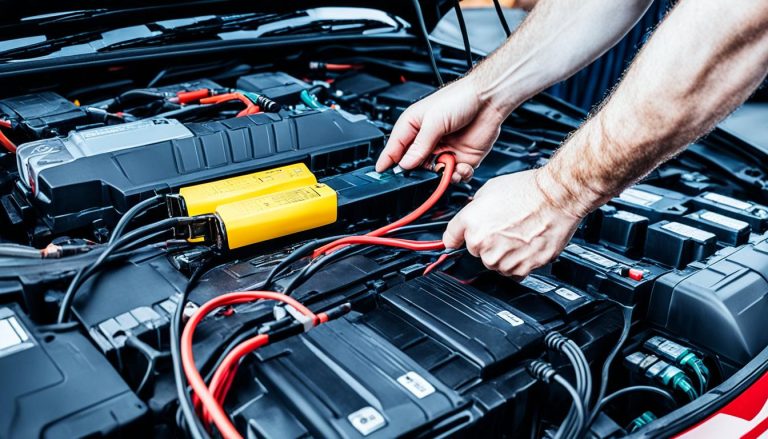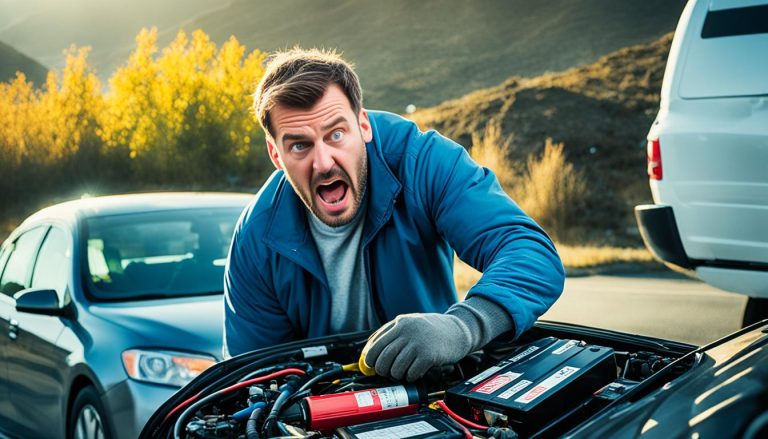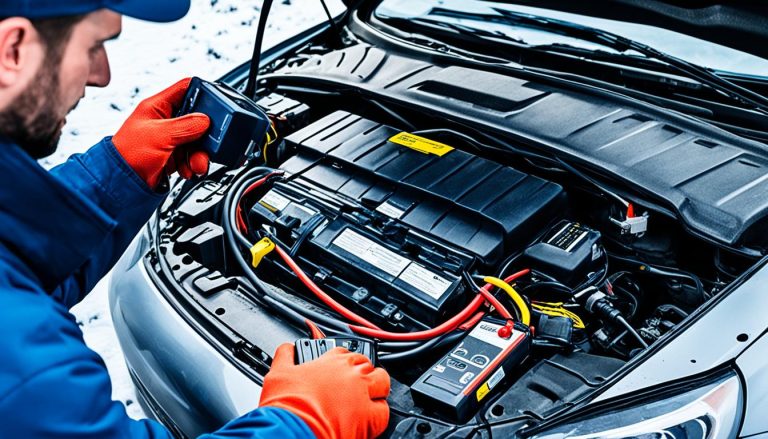Car Needs Jump Start But Battery Is Good: Why?
batterychargers.site and its partners may earn a commission if you purchase a product through one of our links
You hop in your vehicle, ready to start your day—coffee in hand, ready to go. But when you turn the key, there’s nothing. No crank, no roar to life, just silence. It’s confusing and frustrating, especially since your car’s battery seems to be in tip-top shape. You’ve just stumbled into a common dilemma: your car needs a jump start although the battery is good. The perplexing situation where a car won’t start but the battery still holds a charge indicates that something else may be afoot.
Before you lean into the instant troubleshoot of aiming to jump start your car, let’s explore some possible culprits. It could be a crafty issue with your vehicle’s electrical system that doesn’t necessarily ring the everyday alarms or wave glaring red flags. We’re here to untangle this automotive enigma and shed some light on why your car plays dead despite a lively battery.
Key Takeaways
- Jump starting a vehicle with a good battery suggests an underlying issue, often unrelated to the battery’s health.
- Hidden electrical system complications can test your automotive patience and diagnostic skills.
- Even if lights and accessories appear functional, they don’t outright dismiss a battery concern—subtle signs are key.
- Smart vehicle maintenance and awareness can avert the sudden need to jump start your car.
- Understanding the relationships among your car’s battery, alternator, and starter is crucial to pinpoint the real issue.
- Educating yourself on common car starting misconceptions can save time and potential repair costs.
Understanding the Basics of Car Starting Issues
When it comes to troubleshooting car battery problems, it’s essential to understand the interaction between the various components of your car’s electrical system. A car that won’t start can pose several questions, and knowing how to jump start a car is just one part of resolving these issues. Let’s delve into the complexities of your vehicle’s starting mechanism and clear up some common misconceptions.
How the Battery, Alternator, and Starter Interact
Think of your car’s electrical system as a trio of performers in a band. Each must play their part correctly for the music to sound right. The battery kicks off the performance by providing the necessary power to start the engine. Once the engine is running, the alternator takes the stage, charging the battery and powering the car’s electrical systems. The starter acts like a manager, making sure the engine jumps into action. Should one member of this trio falter, it affects the entire concert of components, often misguiding you into diagnosing a problem with the wrong part.
Common Symptoms and Misconceptions
It’s a common scene: dim headlights lead you to believe the issue lies exclusively within the battery. Or perhaps, your car accessories operate flawlessly, causing you to overlook a potential battery problem. However, these symptoms on their own don’t always point to the correct culprit. A weak battery can masquerade as a failing starter motor, whereas alternator issues might disguise themselves as battery weaknesses – all leading to the typical dilemma where your car requires a jump start.
The Role of the Car’s Electrical System
Recognizing the significant and interconnected role of your car’s electrical system is vital for proper maintenance and troubleshooting. This system is the lifeline that ensures your vehicle operates smoothly and reliably. Without each part functioning in harmony, you may find yourself repeatedly addressing the same car battery problems or struggling with jump-starting your car – an often inconvenient and unexpected pitfall.
Now that you have a better understanding of the basics, you’ll be better equipped to diagnose issues and take effective action. Remember, whether it’s poor lighting, a hesitant start, or complete failure to crank, these are merely symptoms indicating it’s time to take a closer look at your car’s electrical system.
The Car Needs Jump Start But Battery Is Good: Investigating the Paradox
It’s a frustrating scenario: you attempt to start your car and, despite a battery that seems in good health, the engine won’t crank. The need for jumpstarting comes as a surprise, but it’s a situation that can reveal hidden issues with your vehicle’s electrical system. Before you find yourself stranded with a car that won’t start, let’s delve into some of the common reasons why your car might need a helping hand despite having a good battery, and how you can address these concerns.

Parasitic Drains and Their Impact on Battery Charge
One of the primary suspects behind why your car battery may appear to be dead despite showing prior signs of good health is a parasitic drain. This somewhat stealthy culprit operates by siphoning off electricity from the battery when your car is off – think of it as a small device left running or a light that fails to switch off. Without attention, these drains can leave a battery depleted, leading to a situation where the power necessary to start the engine is lacking. Key to addressing this is identifying and rectifying these energy leaks, ensuring your battery retains its charge.
How Alternator Issues Can Masquerade as Battery Problems
Another piece of the puzzle lies with the alternator, a vital component tasked with keeping your battery charged while the engine runs. A failing or inefficient alternator can give the impression of your car battery being dead when, in fact, the issue is its inability to recharge the battery while you drive. This is particularly misleading, as the symptoms can emulate those of a battery past its prime. Through proper diagnosis, you can distinguish between a battery that simply needs replacing and deeper electrical system issues.
Checks and Tests to Isolate the Issue
When faced with a car that requires jumpstarting but seems to have a healthy battery, it’s crucial to conduct systematic checks and tests. This involves meticulous inspection for any electrical device or component that should not be active while the car is turned off. Additionally, thorough testing of the alternator’s output and the battery’s state of health is needed, often involving specialized equipment that can gauge whether the alternator is fulfilling its charging role effectively. It’s through these assessments that you can determine the real perpetrator, be it a phantom drain or an alternator in distress, and take corrective action to prevent future start-up woes.
Jump Start Car Techniques and Precautions
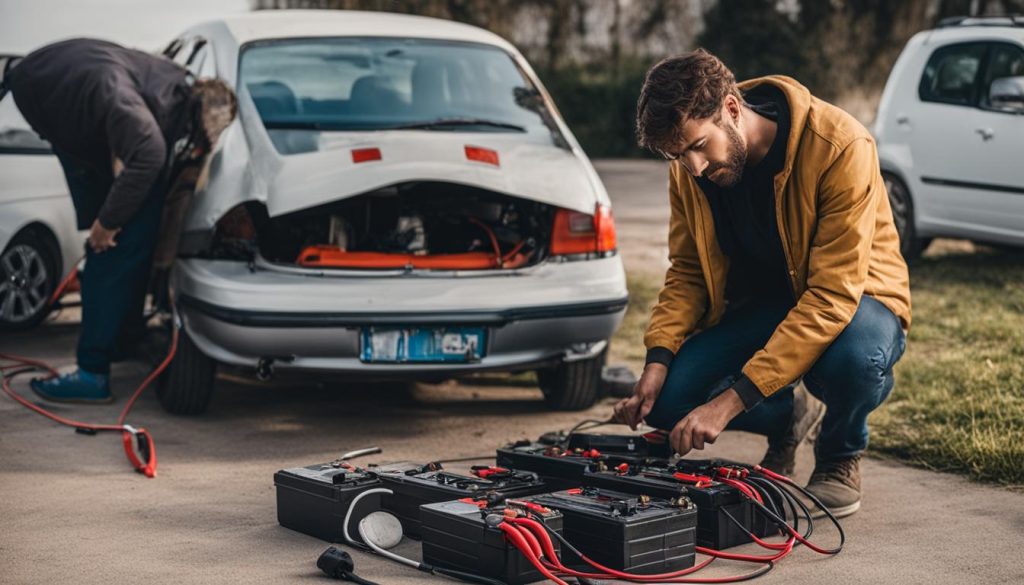
When the need arises to jump start a car, it’s crucial to handle the situation with care to avoid any injuries or damage to your car’s electrical system. The process is straightforward, but certain safety protocols should always be followed. Here’s what you need to know about how to safely car jump start.
- Firstly, make sure both cars are turned off, with keys removed from the ignition.
- Open the hood of each car and locate their batteries and battery terminals.
- Identify the positive (usually red) and negative (usually black) terminals.
It’s essential to connect the jumper cables correctly – the positive clamp to the positive terminal of the battery needing a charge, and the same with the negative. However, for the car providing power, attach the negative clamp to a ground point, such as a shiny, non-painted metal surface away from the battery.
| Step | Action | Reason |
|---|---|---|
| 1 | Connect positive clamp to weak battery’s positive terminal | Establishing a circuit to transfer power |
| 2 | Connect positive clamp to good battery’s positive terminal | Linking the source of power |
| 3 | Connect negative clamp to good battery’s negative terminal | Completing the circuit on the power source side |
| 4 | Attach other negative clamp to an unpainted metal surface | Creating a safe ground on the car being jump-started |
| 5 | Start working vehicle, then attempt to start the other vehicle | Power is transferred and if successful, the weak battery comes to life |
After successfully starting the vehicle, remove the jumper cables in the reverse order of attachment, being careful not to let the clamps touch each other or any metal surfaces.
If you find that your car starts after receiving a jump start but refuses to start again later, it’s likely time to check the battery itself. Despite your best efforts in how to jump start a car, a battery that won’t hold a charge will need to be replaced. Always remember: jump starting is not a cure-all for underlying issues that may need further diagnosis by a professional.
In summary, jump starting is a valuable skill to get you out of a bind, but it should be approached with caution and respect for the potential hazards. By following these steps, you ensure not only a successful jump start but also your safety and that of your vehicle. Should you encounter any difficulty or if the car does not start after a jump, seek professional assistance to avoid risking injury or damage to your car’s electrical system.
Car Won’t Start or Crank: Beyond the Battery
When you find yourself with a car that won’t start or even crank, it’s easy to suspect a car battery dead in the driver’s seat of your problems. However, automotive conundrums often extend beyond the battery alone. Let’s put on our detective caps and navigate through the less treaded paths of transmission and fuel system troubleshooting, ignition system intricacies, and the cryptic world of electrical components.
Transmission and Fuel System Troubleshooting
It’s not uncommon for transmission issues to throw you off track in the diagnostic process. A Ford might not just spring into gear, mimicking a dead battery, not due to power issues but potentially due to a software mishap. Similarly, don’t overlook your fuel system—a clogged fuel filter or a failed fuel pump can leave your engine starving and silent.
Addressing Ignition System Failures
Failure to fire all cylinders can often come down to a faulty ignition system. Spark plugs, ignition coils, or distributor—if you’ve got one—all play a critical role in getting your engine running. When one goes rogue, your car’s response is to sit tight and remain unresponsive.
Navigating Electrical Component Anomalies
It’s the less-thought-of electrical culprits that can often be the silent battery killers. A sly aftermarket alarm impeccably installed yet imperfect in its function, or a seat adjuster that forgets to turn off, can be the unexpected vampires of vehicle voltage.
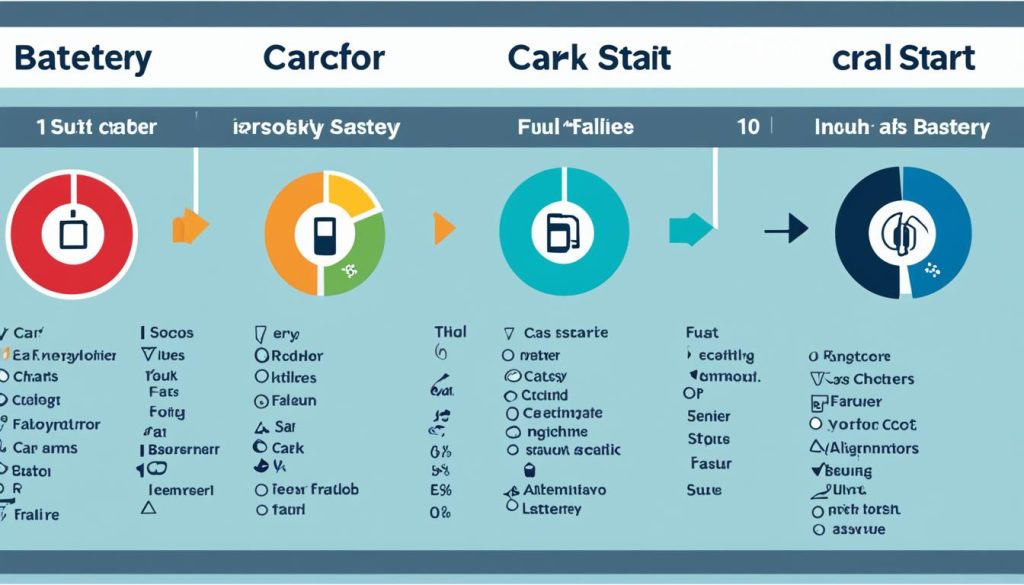
Here’s a helpful breakdown to aid in wrapping your mind around these potential issues:
| System | Symptoms | Potential Causes |
|---|---|---|
| Transmission | Delay in gear engagement | Software issues, failing solenoid |
| Fuel System | Engine turns over, but won’t start | Clogged fuel filter, failed fuel pump |
| Ignition System | No engine turnover, no spark | Faulty spark plugs, ignition coil, distributor |
| Electrical Components | Battery drain with no obvious signs | Aftermarket alarm, stuck electric seat adjuster |
To sum it up, a car won’t crank situation isn’t always straightforward. When you’re confronted with silence under your hood, looking beyond the battery to the other players in the game may illuminate the path to a resolution. Remember, a multi-faceted approach to troubleshooting is key to your automotive harmony.
Maintenance Tips to Avoid Untimely Jump Starts
Preventing unwelcome surprises, such as your car needs jump start, begins with regular and diligent car maintenance. It’s crucial to check your charging system’s health, which includes the battery, alternator, and cables. Be proactive about inspecting these elements to catch any early indications of wear or corrosion, as these minor issues can balloon into major headaches down the road. Remember, proactive monitoring may save you from being stranded with car battery problems when you least expect them.
Batteries have a finite lifespan, normally ranging from four to five years. It’s wise to be aware of this timeline and consider replacement before failure occurs. If you leave your vehicle unused for extended periods, this can be detrimental to your battery’s charge, since the alternator depends on a running engine to recuperate its power. Additionally, take care to turn off all electrical components such as lights and the radio when your car is not in use. This helps to thwart any unnecessary battery depletion that could later necessitate a jump start.
Lastly, familiarize yourself with your vehicle’s specific maintenance schedule, and don’t hesitate to consult with professionals to keep your car in tip-top condition. Regular tune-ups, fluid checks, and brake inspections contribute to the overall health of your vehicle, not just the battery. By staying on top of these areas, you’re not simply maintaining your car—you’re safeguarding your mobility and peace of mind. So, keep your car’s needs in check, and you’ll likely steer clear of those untimely jump starts.
FAQ
Why does my car need a jump start if my battery is good?
Your car might need a jump start even if the battery appears to be good due to underlying issues such as a parasitic drain or alternator problems, which prevent the battery from maintaining a charge sufficient to start the vehicle.
How can I tell if my car won’t start due to the battery or another issue?
To determine if the issue is the battery, check for symptoms like dim lights that become brighter when the engine starts, which could indicate an alternator problem. Also, a good battery testing by a professional can help differentiate between a battery issue and other electrical system failures.
What are the basic interactions between the battery, alternator, and starter?
The battery supplies the initial power to start the car. Once the engine is running, the alternator recharges the battery and powers the electrical systems. The starter uses the battery’s power to turn the engine over and begin the combustion process.
What are some common car starting misconceptions?
Some misconceptions include thinking a car with dim lights cannot have a battery issue or assuming if the car’s accessories work, the battery must be fine. Another is mistaking a weak battery for a faulty starter when the engine struggles to crank.
How can parasitic drains affect my car’s battery charge?
Parasitic drains occur when your car’s electrical devices continue drawing power from the battery while the engine is off. Over time, they can deplete the battery to a point where it lacks the charge necessary to start the engine.
How can alternator issues mimic battery problems?
Alternator issues can lead to a battery not getting properly charged, which can present signs similar to a failing battery, such as a car that won’t start or a battery that loses charge quickly after being jump-started.
What checks and tests can isolate a car starting issue?
To isolate a car starting issue, a professional can conduct tests including a battery load test, checking the alternator output and looking for any electrical components that shouldn’t be drawing power when the car is off.
What techniques and precautions should I follow to jump start my car safely?
When jump-starting your car, use heavy-duty, well-insulated jumper cables, connect the cables in the correct order, start the functioning car first before the car with the dead battery, and ensure the cables do not touch each other to prevent sparking and potential harm.
What should I check if my car won’t start or crank, and it’s not the battery?
Beyond the battery, check the transmission and fuel system to ensure they are engaging and operating properly. Also, investigate the ignition system, including spark plugs and ignition coils, and consider any electrical anomalies like aftermarket alarm systems or powered accessories that may drain the battery.
What maintenance tips can help avoid the need for jump starts?
To avoid untimely jump starts, regularly maintain your car’s charging system, replace the battery based on its expected lifespan, avoid long periods of inactivity for your vehicle, and ensure you turn off all electrical components when the engine isn’t running to prevent battery drain.

